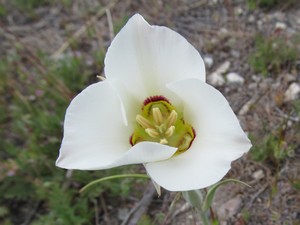

Click on any picture to see a much larger version.
I got to Salt Lake City on Saturday and we went to the Botanical Gardens, but I didn't take that many pictures. On Sunday we decided to go up to Promontory Point and visit the Golden Spike National Historic Site. It is actually not at Promontory Point, but is on Promontory Summit (the Point being down closer to the lake). While the transcontinental railroad was enormously important at the time, after 35 years or so, the route of the railroad was moved to a 12-mile trestle (eventually an earth causeway) across the Great Salt Lake (which I got to see on this trip a couple of times, but there really isn't much to see), eliminating grades up Promontory Summit and 45 miles of track. Then in World War 2 the tracks were taken up to recycle the steel.
Eventually they put some new track in and replicas of the two trains that met at that point: the Jupiter belonging to the Central Pacific, arriving from California, and the 119 belonging to the Union Pacific, coming from the East. The golden spike and the last tie were taken up the day of the ceremony. They have a lacquered tie in place and a plaque. And they run the 119 up to the junction every hour or so. Both of the replicas look like they are in great shape and are painted very brightly. However the Jupiter has a steel wheel that is flat on one side, so it mostly just sits there. Due to the nature of available materials of the time, the Jupiter burns wood to make steam while the 119 burns coal.
Both replicas are kept steamed up. The visitor center explains about the construction of the transcontinental railroad and then you can wander around the area and see the old railroad grades. Because the railroad companies were paid by the mile, they actually passed each other for a couple of miles to make a little more money before the government said that was enough. So part of the grade was never used.
Susan didn't think this was very interesting, but I had read Nothing Like It in the World about the construction, so I thought it was pretty interesting. After visiting we took a driving tour of a few spots to see some of the cuts and fills and a few other points of interest, but we didn't have the guidebook to tell us what all the different points were. There were information boards at a few spots though, including "the last cut" which looks like a ditch with a pile of rocks up on the banks. But you could definitely follow the line of the railroad. We also saw a bunch of tumbleweeds in that area, which I thought was pretty cool.
After we got home I walked the dogs around the block and we dawdled in general before heading out for Bonneville Salt Flats. I was afraid it would be dark by the time we got there (it is a 2-hour drive), but Susan thought sunset was around 8:45 and that we could make it. Plus we were going West which would help us a little. We passed by lower end of the Great Salt Lake, but it isn't really that much to look at. There are boats on it, which surprised me since there aren't fish and I don't know that people swim in it, plus it seems like the salt would corrode everything. There was a Morton salt plant along the way.
The Bonneville Salt Flats are left over from Lake Bonneville, a huge version of the Great Salt Lake that covered most of northwestern Utah and was nearly the size of Lake Michigan. The Bonneville Salt Flats are famous for being the spot of speed trials for the fastest vehicles in the world and has also appeared in a lot of movies. Not all that smooth, it is a big expanse of very flat land with no obstructions. Salt doesn't make for great traction, so acceleration and braking aren't all that important.
There is a rest area on Interstate 80 at about milepost 11 where you can walk out onto the flats. There aren't any fences because there are no people or livestock for miles. The place is a wasteland. But we got there right at sunset which was perfect. There was a guy filming some kind of music video of a girl. There was enough water that you had to take your shoes off and walk barefoot at first, but it was mostly just puddles close the rest area and then dry after that. We both tasted the salt and it was definitely salt. The distant mountains are much larger than they appear in photographs and not as distant either. It is a very cool place. After that we drove a couple of miles further West which put us into West Wendover, Nevada, which has gambling. Because it was pretty late (about 9:30 and it was a 2-hour drive back to Salt Lake City) we just ate at McDonald's.
On the way back they had signs where you could test out your speedometer. By holding your speed at 75 mph between the signs, they would tell you how many seconds should have elapsed. At the first sign you should be at 48 seconds. Then 96 seconds, etc. It did this for 5 miles. And the road was pretty much straight and flat with very little traffic, so it was a great place to do a test like that. It turns out the Prius speedometer exaggerates speed, saying it was 75 mph, but actually taking longer than 48 seconds to do a mile. Susan said that her GPS, which reads out speed all the time, confirmed that. You could do this anytime with mileposts, I guess, but it was a good way to stay awake on a very boring stretch of road.